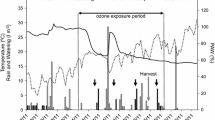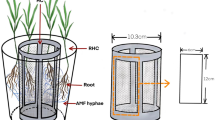Abstract
Increasing concentrations of tropospheric ozone and reactive nitrogen threaten the composition and function of semi-natural plant communities. Using a free-air fumigation system, we investigated the effects of elevated ozone (1.73 × ambient concentration; +O3) and nitrogen (+50 k g N ha year−1; +N) deposition on growth of juveniles of three subalpine grassland species and their colonization by arbuscular mycorrhizal fungi (AMF) in situ. In a subsample, the extra-radical mycelium was regularly disrupted to determine the effect of AMF on the plants’ pollutant sensitivity. The plants reacted sensitively to the pollutants: +N increased shoot growth in Festuca rubra, while +O3 decreased root growth in Trifolium alpinum and F. rubra. Colonization with AMF was stimulated by N in Leontodon helveticus and was strongly reduced by O3 in F. rubra and L. helveticus, probably due to lower carbon allocation belowground. Conversely, AMF did not protect plants from O3 neither did they increase the species’ responsiveness to N. Our results indicate that irrespective of AMF colonization, juvenile plants are highly sensitive to O3 stress, probably since their growth is primarily limited by carbon assimilation.

Similar content being viewed by others
References
Andersen, C. P. (2003). Source-sink balance and carbon allocation below ground in plants exposed to ozone. New Phytologist, 157, 213–228.
Bassin, S., Volk, M., & Fuhrer, J. (2007a). Factors affecting the ozone sensitivity of temperate European grasslands: an overview. Environmental Pollution, 146, 678–691.
Bassin, S., Volk, M., Suter, M., Buchmann, N., & Fuhrer, J. (2007b). Nitrogen deposition but not ozone affects productivity and community composition of subalpine grassland after 3 yr of treatment. New Phytologist, 175, 523–534.
Bassin, S., Werner, R. A., Soergel, K., Volk, M., Buchmann, N., & Fuhrer, J. (2009). Effects of combined ozone and nitrogen deposition on the in situ properties of eleven key plant species of a subalpine pasture. Oecologia, 158, 747–756.
Bassin, S., Schalajda, J., Vogel, A., & Suter, M. (2012). Different types of sub-alpine grassland respond similarly to elevated nitrogen deposition in terms of productivity and sedge abundance. Journal of Vegetation Science, 23, 1024–1034.
Bassin, S., Volk, M., & Fuhrer, J. (2013). Species composition of subalpine grassland is sensitive to nitrogen deposition, but not to ozone, after seven years of treatment. Ecosystems, 16, 1105–1117.
Blanke, V., Bassin, S., Volk, M., & Fuhrer, J. (2012). Nitrogen deposition effects on subalpine grassland: the role of nutrient limitations and changes in mycorrhizal abundance. Acta Oecologica-International Journal of Ecology, 45, 57–65.
Burnham, K. P., & Anderson, D. R. (2002). Model selection and multimodel interference: A practical-theoretical approach. Berlin: Springer.
Craine, J. M. (2006). Competition for nutrients and optimal root allocation. Plant and Soil, 285, 171–185.
Cui, X. C., Hu, J. L., Lin, X. G., Wang, F. Y., Chen, R. R., Wang, J. H., & Zhu, J. G. (2013). Arbuscular mycorrhizal fungi alleviate ozone stress on nitrogen nutrition of field wheat. Journal of Agricultural Science and Technology, 15, 1043–1052.
Evelin, H., Kapoor, R., & Giri, B. (2009). Arbuscular mycorrhizal fungi in alleviation of salt stress: a review. Annals of Botany, 104, 1263–1280.
Fellbaum, C. R., Mensah, J. A., Cloos, A. J., Strahan, G. E., Pfeffer, P. E., Kiers, E. T., & Bücking, H. (2014). Fungal nutrient allocation in common mycorrhizal networks is regulated by the carbon source strength of individual host plants. New Phytologist, 203, 646–656.
Fitter, A. H., & Nichols, R. (1988). The use of benomyl to control infection by vesicular-arbuscular mycorrhizal fungi. New Phytologist, 110, 201–206.
Grantz, D. A., Gunn, S., & Vu, H. B. (2006). O3 impacts on plant development: a meta-analysis of root/shoot allocation and growth. Plant, Cell and Environment, 29, 1193–1209.
Hayes, F., Mills, G., Williams, P., Harmens, H., & Büker, P. (2006). Impacts of summer ozone exposure on the growth and overwintering of UK upland vegetation. Atmospheric Environment, 40, 4088–4097.
Hayes, F., Jones, M. L. M., Mills, G., & Ashmore, M. (2007). Meta-analysis of the relative sensitivity of semi-natural vegetation species to ozone. Environmental Pollution, 146, 754–762.
Heinemeyer, A., Ridgway, K. P., Edwards, E. J., Benham, D. G., Young, J. P. W., & Fitter, A. H. (2004). Impact of soil warming and shading on colonization and community structure of arbuscular mycorrhizal fungi in roots of a native grassland community. Global Change Biology, 10, 52–64.
Hildebrandt, U., Regvar, M., & Bothe, H. (2007). Arbuscular mycorrhiza and heavy metal tolerance. Phytochemistry, 68, 139–146.
Johnson, D., Leake, J. R., & Read, D. J. (2001). Novel in-growth core system enables functional studies of grassland mycorrhizal mycelial networks. New Phytologist, 152, 555–562.
Johnson, N. C., Rowland, D. L., Corkidi, L., & Allen, E. B. (2008). Plant winners and losers during grassland N-eutrophication differ in biomass allocation and mycorrhizas. Ecology, 89, 2868–2878.
Johnson, N. C., Wilson, G. W. T., Bowker, M. A., Wilson, J. A., & Miller, R. M. (2010). Resource limitation is a driver of local adaptation in mycorrhizal symbioses. Proceedings of the National Academy of Sciences of the United States of America, 107, 2093–2098.
Johnson, N. C., Wilson, G. W. T., Wilson, J. A., Miller, R. M., & Bowker, M. A. (2015). Mycorrhizal phenotypes and the Law of the Minimum. New Phytologist, 205, 1473–1484.
Karanika, E. D., Mamolos, A. P., Alifragis, D. A., Kalburtji, K. L., & Veresoglou, D. S. (2008). Arbuscular mycorrhizas contribution to nutrition, productivity, structure and diversity of plant community in mountainous herbaceous grassland of northern Greece. Plant Ecology, 199, 225–234.
Kytöviita, M. M., Thiec, D. L., & Dizengremel, P. (2001). Elevated CO2 and ozone reduce nitrogen acquisition by pinus halepensis from its mycorrhizal symbiont. Physiologia Plantarum, 111, 305–312.
Larcher, W. (2003). Physiological plant ecology: ecophysiology and stress physiology of functional groups. Heidelberg: Springer.
McCool, P., & Menge, J. (1983). Influence of ozone on carbon partitioning in tomato: potential role of carbon flow in regulation of the mycorrhizal symbiosis under conditions of stress. New Phytologist, 94, 241–247.
McGonigle, T., Miller, M., Evans, D., Fairchild, G., & Swan, J. (1990). A new method which gives an objective measure of colonization of roots by vesicular–arbuscular mycorrhizal fungi. New Phytologist, 115, 495–501.
Merrild, M. P., Ambus, P., Rosendahl, S., & Jakobsen, I. (2013). Common arbuscular mycorrhizal networks amplify competition for phosphorus between seedlings and established plants. New Phytologist, 200, 229–240.
Miller, J. E., Shafer, S. R., Schoeneberger, M. M., Pursley, W. A., Horton, S. J., & Davey, C. B. (1997). Influence of a mycorrhizal fungus and/or rhizobium on growth and biomass partitioning of subterranean clover exposed to ozone. Water, Air, and Soil Pollution, 96, 233–248.
Milleret, R., Le Bayon, R. C., Lamy, F., Gobat, J. M., & Boivin, P. (2009). Impact of roots, mycorrhizas and earthworms on soil physical properties as assessed by shrinkage analysis. Journal of Hydrology, 373, 499–507.
O’Connor, P. J., Smith, S. E., & Smith, F. A. (2002). Arbuscular mycorrhizas influence plant diversity and community structure in a semiarid herbland. New Phytologist, 154, 209–218.
Oehl, F., Schneider, D., Sieverding, E., & Burga, C. A. (2011). Succession of arbuscular mycorrhizal communities in the foreland of the retreating Morteratsch glacier in the Central Alps. Pedobiologia, 54, 321–331.
Pinheiro, J. C., & Bates, D. M. (1996). Unconstrained parametrizations for variance-covariance matrices. Statistics and Computing, 6, 289–296.
R Development Core Team. (2011). R: a language and environment for statistical computing. Vienna: R Foundation for Statistical Computing.
Read, D., & Haselwandter, K. (1981). Observations on the mycorrhizal status of some alpine plant communities. New Phytologist, 88, 341–352.
Reynolds, H. L., Hartley, A. E., Vogelsang, K. M., Bever, J. D., & Schultz, P. A. (2005). Arbuscular mycorrhizal fungi do not enhance nitrogen acquisition and growth of old-field perennials under low nitrogen supply in glasshouse culture. New Phytologist, 167, 869–880.
Ruiz-Sánchez, M., Aroca, R., Muñoz, Y., Polón, R., & Ruiz-Lozano, J. M. (2010). The arbuscular mycorrhizal symbiosis enhances the photosynthetic efficiency and the antioxidative response of rice plants subjected to drought stress. Journal of Plant Physiology, 167, 862–869.
Sanz, J., Bermejo, V., Muntifering, R., Gonzalez-Fernandez, I., Gimeno, B. S., Elvira, S., & Alonso, R. (2011). Plant phenology, growth and nutritive quality of Briza maxima: responses induced by enhanced ozone atmospheric levels and nitrogen enrichment. Environmental Pollution, 159, 423–430.
Shane, M. W., Cawthray, G. R., Cramer, M. D., Kuo, J., & Lambers, H. (2006). Specialized ‘dauciform’ roots of Cyperaceae are structurally distinct, but functionally analogous with ‘cluster’ roots. Plant, Cell and Environment, 29, 1989–1999.
Smith, S. E., & Read, D. J. (2008) Mycorrhizal Symbiosis. Academic Press, London, UK.
Smith, M. D., Hartnett, D. C., & Rice, C. W. (2000). Effects of long-term fungicide applications on microbial properties in tallgrass prairie soil. Soil Biology and Biochemistry, 32, 935–946.
Tester, M., Smith, F. A., & Smith, S. E. (1985). Phosphate inflow into Trifolium subterraneum L.: effects of photon irradiance and mycorrhizal infection. Soil Biology and Biochemistry, 17, 807–810.
Treseder, K. K. (2013). The extent of mycorrhizal colonization of roots and its influence on plant growth and phosphorus content. Plant and Soil, 371, 1–13.
Treseder, K. K., & Allen, M. F. (2002). Direct nitrogen and phosphorus limitation of arbuscular mycorrhizal fungi: a model and field test. New Phytologist, 155, 507–515.
Vainonen, J. P., & Kangasjärvi, J. (2015). Plant signalling in acute ozone exposure. Plant, Cell & Environment, 38, 240–252.
Vierheilig, H., Coughlan, A. P., Wyss, U., & Piché, Y. (1998). Ink and vinegar, a simple staining technique for arbuscular-mycorrhizal fungi. Applied and Environmental Microbiology, 64, 5004–5007.
Volk, M., Wolff, V., Bassin, S., Ammann, C., & Fuhrer, J. (2014). High tolerance of subalpine grassland to long-term ozone exposure is independent of N input and climatic drivers. Environmental Pollution, 189, 161–168.
Wahl, A. L., & Spiegelberger, T. (2016). Arbuscular mycorrhizal fungi in changing mountain grassland ecosystems: a challenge for research. Botany, 94, 435–458.
Wang, S. G., Wang, F., Diao, X. J., & He, L. S. (2014). Effects of elevated O3 on microbes in the rhizosphere of mycorrhizal snap bean with different O3 sensitivity. Canadian Journal of Microbiology, 60, 93–103.
Wang, S. G., Diao, X. J., Li, Y. W., & Ma, L. M. (2015). Effect of Glomus aggregatum on photosynthetic function of snap bean in response to elevated ozone. Journal of Agricultural Science, 153(5), 837–852.
Wildi, B., & Lütz, C. (1996). Antioxidant composition of selected high alpine plant species from different altitudes. Plant, Cell and Environment, 19, 138–146.
Wilson, G. W. T., Rice, C. W., Rillig, M. C., Springer, A., & Hartnett, D. C. (2009). Soil aggregation and carbon sequestration are tightly correlated with the abundance of arbuscular mycorrhizal fungi: results from long-term field experiments. Ecology Letters, 12, 452–461.
Wyness, K., Mills, G., Jones, L., Barnes, J. D., & Jones, D. L. (2011). Enhanced nitrogen deposition exacerbates the negative effect of increasing background ozone in Dactylis glomerata, but not Ranunculus acris. Environmental Pollution, 159, 2493–2499.
Yoshida, L., Gamon, J., & Andersen, C. (2001). Differences in above- and below-ground responses to ozone between two populations of a perennial grass. Plant and Soil, 233, 203–211.
Zhang, T., Sun, Y., Song, Y., Tian, C., & Feng, G. (2011). On-site growth response of a desert ephemeral plant, Plantago minuta, to indigenous arbuscular mycorrhizal fungi in a central Asia desert. Symbiosis, 55, 77–84.
Acknowledgements
This work was supported by the Swiss Federal Office of Environment in the framework of the International Cooperative Programme (ICP Vegetation) under the UNECE CLRTAP and it contributes to the EU project ECLAIRE. The help of Juliane Schalajda, Robin Giger, Victoria Spinas, and Anne-Lena Wahl is greatly acknowledged.
Author information
Authors and Affiliations
Corresponding author
Electronic supplementary material
Below is the link to the electronic supplementary material.
ESM 1
(DOCX 29 kb)
Rights and permissions
About this article
Cite this article
Bassin, S., Blanke, V., Volk, M. et al. Ozone and Nitrogen Effects on Juvenile Subalpine Plants: Complex Interactions with Species and Colonization by Arbuscular Mycorrhizal Fungi (AMF). Water Air Soil Pollut 228, 30 (2017). https://doi.org/10.1007/s11270-016-3214-3
Received:
Accepted:
Published:
DOI: https://doi.org/10.1007/s11270-016-3214-3




